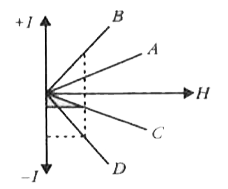The variation of the intensity of magnetisation (I) with respect to the magnetising field (H) in a diamagnetic substance is described by the graph
 Solution in Kannada
Solution in Kannada
OC
OD
OA
OB
The correct Answer is:A

Susceptibility (k) is defined as the ratio of intensity of magnetisation I to the intensity H of the magnetising field, i.e. k=I/H.
Diamagnetic substances possess very small negative values of susceptibilities.
From the figure, it is observed that graphs OC and OD have negative values for k(I/H). the value is also less for the graph OC.
Hence OC represents the variation of I with respect to H in a diamagnetic substance.
Topper's Solved these Questions
Similar Questions
A balloon starts rising from thee ground with an acceleration of 1.25m/s2. After 8 s, a stone is released from the balloon. The stone will (taking g=10ms−2)
View SolutionThe displacement time graph of a particle executing SHM is as shown in the figure. The corresponding force-time graph of the particle is-

View SolutionThe variation of the intensity of magnetisation (I) with respect to the magnetising field (H) in a diamagnetic substance is described by the graph

View SolutionWhen a small magnetising field H is applied to a magnetic material the intensity of magnetisation (I) is proportional to:
View SolutionThe ratio of magnetisation I to the magnetic field intensity H is
View SolutionThe ratio of the intensity of the magnetisation to the strength of magnetising field is called
View SolutionThe relation between magnetic induction(B),magnetising field (H)And the magnetisation (I) is
View SolutionThe variation of the intensity of magnetisation with respect to the magnetisign field H in a diamagnetic substance is described by the graph

View SolutionThe variation of the intensity of magnetization (I) with respect to the magnetizing field (H) in a diamagnetic substance is described by the .
View SolutionAnswer the following questions .
a. Why does a paramagnetic sample display greater magnetisation (for the same magnetising field) when cooled ?
b. Why is diamagnetism , in contrast , almost independent of temperature ?
c. If a toroid uses bismuth for its core, will the the field in the core be (slightly ) greater or (slightly ) less than when the core is empty ?
d. Is the permeability of a ferromagnetic material independent of the magnetic field ? If not, is it more for lower or higher fields ?
e. Magnetic field lines are always nearly normal to the surface of ferreomgnet at every point . (This fact is analogous to the static electric field lines being normal to the surface of conductor at every point). Why ?
f. Would the maximum possible magnetisation of paramagnetic sample be of the same order of magnitude as the magnetisation of ferromagnet ?
View SolutionWhy does a paramagnetic substance display greater magnetisation for the same magnetising field when cooled ? How does a diamagnetic substance respond to similar temperature changes ?
View SolutionThe variation of intensity of magnctization (I) with respect to the magnetising field (H) in a diamagnetic substance is described by the graph
View SolutionWhy does a paramagnetic substance display greater magnetisation for .the same magnetising field when cooled. How does a diamagnetic substance respondto similar temperature changes?
View SolutionThe variation of the intensity of magnetisation (I) with respect to the magnetising field (H) in a diamagnetic substance is described by the graph
View SolutionThe variation of magnetic susceptiblity (χ) with magnetising field (H) for a paramagnetic substance is
View SolutionThe variation of the intensity of magnetisation (l) with respect to the magnetising field (H) in a diamagnetic substance is described by the graph.
View Solution
